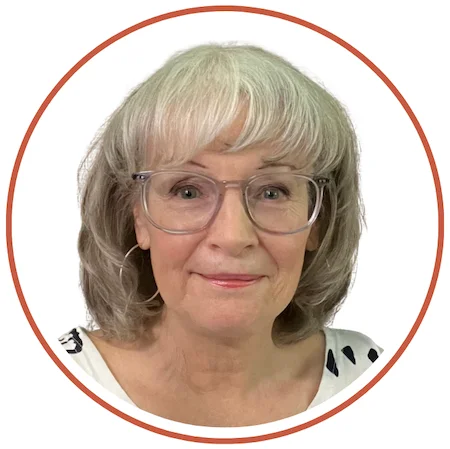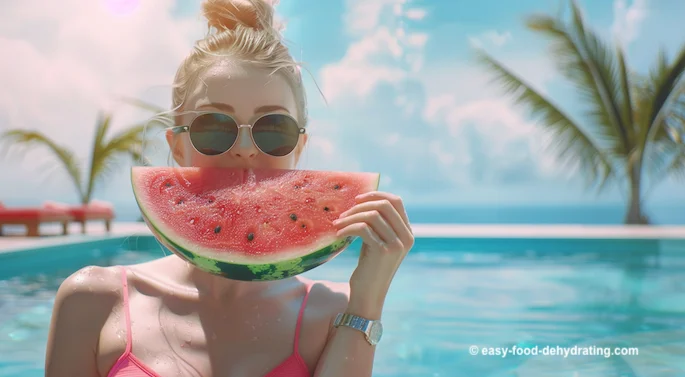How to Dehydrate Melons
Enjoy Honeydew and Watermelon
... All Year Long!
How to Dehydrate Melons
Enjoy Honeydew and Watermelon
... All Year Long!

Susan Gast | Author and blogger at Bored Boomers, Beesville Books, A New Sober You and Easy Food Dehydrating
I want to show you how to dehydrate melons ~ namely the honeydew and the watermelon. The dehydrating "rules" apply to all melons!
I mean, who can resist an enormous slice of chilled watermelon, sitting by the pool with your feet dangling in the water? But watch out for those sticky drips down your chin!

Don't Knock It 'Til You've Tried It!
Have you tried dehydrating melons?
No?
Before I get going, take a minute to read the FAQs below.

Frequently Asked Questions:
Top question is: How do you dehydrate watermelon?
Top question is: How do you dehydrate watermelon?
Scroll down the page to learn how to do just that!
Can you dehydrate watermelon in air fryer?
Can you dehydrate watermelon in air fryer?
Yes, you can dehydrate watermelon in an air fryer! Here are some tips for doing so successfully:
- Cut watermelon into 1/4 to 1/2 inch thick slices or small cubes. Remove any seeds. Blot with paper towels to remove excess moisture.
- Arrange watermelon in a single layer in the air fryer basket without overcrowding. You may need to work in batches. And it's for that reason alone that I prefer using a dehydrator. Why? Because you can dry melon on trays, and Nesco dehydrators allowing for the stacking of multiple trays. With an air fryer, you're kinda stuck drying the melon in one, or two, layers max.
- Set the air fryer to the lowest temperature, around 90°F to 110°F if there is a dehydrate or warm setting. If not, set it as low as possible. And 200°F won't cut it. It'll cook it.
- Dehydrate the watermelon, checking every 30-60 minutes and stirring gently or flipping pieces. Total time will be 6-10 hours.
Watermelon is fully dehydrated when pieces are shrunken down significantly and have a Styrofoam-like texture and no moisture pockets. The pieces should not be sticky.
Store dried watermelon in an airtight container for 2-3 weeks refrigerated or up to 6 months frozen. Enjoy as a sweet, healthy snack!
Be very careful not to over-dry or burn the watermelon due to inconsistent heating. Adjust time and temp as needed based on your particular air fryer model.
Next: How do you dehydrate cantaloupe?
Next: How do you dehydrate cantaloupe?
Treat cantaloupe like you would honeydew which is covered further down this page.
Honeydew and Watermelon Nutrition Info.
Honeydew
VITAMINS: Honeydew melon is rich in Vitamin A and Folate, followed by Vitamin C, and Vitamin K.
MINERALS: Honeydews are loaded with Potassium, followed by Phosphorous and Magnesium.
Honeydew melon is a good source of Omega-3 and Omega-6 fatty acids.
Watermelon
VITAMINS: Watermelons also have a great Vitamin A level, followed by Vitamin C, Folate, and Choline.
MINERALS: Phosphorous, Magnesium, Calcium, Potassium, and Fluoride!
Watermelon is a good source of carbohydrates too, and Omega-6 fatty acids.

Do a Watermelon Ripeness Test First
There are a few ways to tell if your watermelon is ripe and ready to eat.
First, you'll want to make sure the fruit is firm to the touch.
Also, take a sniff near the stem end of the watermelon - it should smell sweet and fragrant.
Lastly, give the melon a gentle thump - if it sounds hollow, it's ready to eat!
Look for a White Patch...
Another way to check to see if your watermelon is ripe, look for a white patch on it.
The white patch means it's been sitting in the field long enough to have created that patch "where the sun don't shine.".. That means it wasn't plucked too soon!
Scroll down to the bottom of the page to learn what to do with your melon seeds...
don't toss 'em, roast 'em!
Scroll down to the bottom of the page to
learn what to do with your melon seeds...
don't toss 'em, roast 'em!

Dehydrating Honeydew Melons: Ripeness Test
For honeydew ripeness testing, clean the oil off your thumb and rub it across the honeydew's surface and if it squeaks, you're good!
Also, if the skin is a pale white, the melon probably would be better if it was a little more on the yellow side before eating.
Honeydew and watermelons are very easy to dehydrate—see the instructions below—and don't forget to roast the seeds (instructions on how to roast melon seeds are coming up!)
How to Dehydrate Melons
Are you ready to get started dehydrating melons? Here's how to do it:
- Remove the skin and seeds from your honeydew or watermelon
- Slice the fruit into 1/2" thick slices and arrange on your food dehydrator trays
- Turn on your food dehydrator and set the temperature between 125°F and 135°F (or per your food dehydrator's instructions).
💡 Tip: Use our Fahrenheit to Celsius converter here on our site!
- Drying time: between 8-20 hours. They can either be pliable, or crisp to your liking, but for long-term storage, the dryer the better!
- Please remember to rotate your dehydrator trays for even drying.
Dehydrated melon is a fantastic snack on its own, but it's also great for adding to trail mix, yogurt, oatmeal, and more. The concentrated melon flavor is like a burst of summer sunshine!
Best Areas for Growing Melons

Melons are a versatile fruit that can be used in sweet and savory dishes alike. If you're looking to add this tasty fruit to your garden, you'll want to make sure you have the right conditions for growing melons.
According to The Old Farmer's Almanac, melons need full sun and well-drained, fertile soil with a pH between 6.0 and 7.0.
When it comes to planting, you'll want to start your melon seeds indoors about three weeks before the last spring frost.
Once it's time to transplant the seedlings outdoors, make sure to space them 48 inches apart in rows that are 8 feet apart.
Roast The Seeds! They're Delicious...
NOTE: Don't toss the seeds. If you are so inclined, you can roast the seeds.
Let them dry thoroughly after giving them a good cleaning/rinse in your sieve under the kitchen faucet.
Spray the seeds first with plain cooking spray and a dash of salt.
Toss them on a cookie sheet for 15 to 20 minutes at 325°F.
💡 Tip: Use our Fahrenheit to Celsius converter here on our site!
Best eaten when fully cooled.
We hope you had fun learning how to dehydrate melons and roasting their seeds!
Thanks for stopping by to learn how to dehydrate melons!
Don't forget to grab your free Six Simple Steps eBook! It’s packed with tips for dehydrating everything from fruits and veggies to dog treats. Get it here.
Before You Go...
If you like the content, please give me some love by clicking on the 🩷 in the lower right hand corner (on just about all my pages). This signals to me that you find it enjoyable and useful. Thank you so much!
















